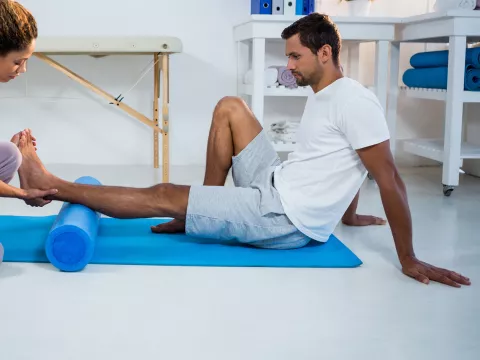- AdventHealth

If your first few steps every morning cause you severe heel pain, you could have plantar fasciitis. This overuse injury affects the sole of your foot—specifically a fibrous band of tissue (plantar fascia) that runs from your heel bone to your toes.
Learning about this condition may help you prevent it, or treat it properly if you already have it.
Symptoms of Plantar Fasciitis
Plantar fasciitis tends to start with mild pain at the heel bone. The pain is likely to occur after exercise and resting, but not while you’re working out.
Some people with the condition report that walking relieves the pain, but it returns after they spend long amounts of time on their feet.
Causes
Plantar fasciitis has several causes. Some can be controlled, while others can’t. Risk factors include:
• Getting older, which causes the fat pad on the heel to thin and be less effective at absorbing the shock of walking
• Having flat feet or a high arch
• Being overweight
• Having diabetes
• Spending a lot of time on your feet
• Increasing your level of physical activity too quickly within a short period of time
• Wearing shoes without proper support on hard, flat surfaces for extended periods of time
Treatment
Most people with the condition respond to appropriate self-care and nonsurgical treatments over time. Effective treatments include:
• Doing exercises that stretch the foot and calf. Here’s one exercise to try: Stand up with your hands pressed flat against a wall and your sore foot slightly behind the other foot. Keep your heels flat on the floor as you slowly bend both knees. Hold for 10 to 15 seconds; repeat six to eight times. Switch legs and repeat if your other foot is also sore.
• Not walking barefoot.
• Applying ice to the heel area for 20 minutes several times a day to reduce inflammation. Wrap the ice in a thin towel before applying.
• Wearing shoes that support the arch and have a slightly raised heel.
• Cutting back on activity to give your heel a rest.
• If these self care steps do not provide relief, your doctor may prescribe orthotic devices, heel pads, walking casts, or night splints, or suggest medical treatments such as corticosteroid injections.
For long-term pain relief, it’s important to address the underlying causes of the condition, such as wearing shoes without proper support or not maintaining a healthy weight.
If heel pain is affecting your ability to live out your best life, connect with one of our whole-health experts at Call844-362-2329.




